Ha Giang is probably a name that is no longer unfamiliar to many people. The land at the beginning of the Fatherland with many beautiful landscapes and friendly and hospitable people, but the border area still has many difficulties. In 2016, Ha Giang welcomed many tourists, but there are still lands and people you have passed through but may not fully understand about that land. I will join you to visit more in Ha Giang.
Table of Contents
Top 10 most beautiful landscapes in Ha Giang province
Thanh Thuy border gate
As mentioned, Thanh Thuy border gate is the largest border gate in Ha Giang. This is also the only official border gate in Ha Giang, taking on the important task of trading official goods from China to Vietnam and vice versa.
Thanh Thuy border gate is located in Thanh Thuy commune, Vi Xuyen district, about 20 km north of Ha Giang city. Connecting with the Thanh Thuy border gate is the Thien Bao border gate in the Malipo district, Yunnan Province, China. This is an important border gate not only for Ha Giang but also for the whole country.
Thanh Thuy is a place for trade exchanges between Ha Giang people in particular and Vietnam in general and China. Trade and exchange here take place very bustlingly, it promotes the economic development of the two countries, and the relationship between the two countries becomes closer. In addition to trading activities, this is also a cultural trade route between the two countries. During the year, there are many visits between students of the two countries and large economic projects.
The Thanh Thuy border gate brings great value in all aspects, this is an opportunity to facilitate cultural exchange more easily. This is also a place where security is always tightened, border guards are always on guard and on duty to ensure order and safety.
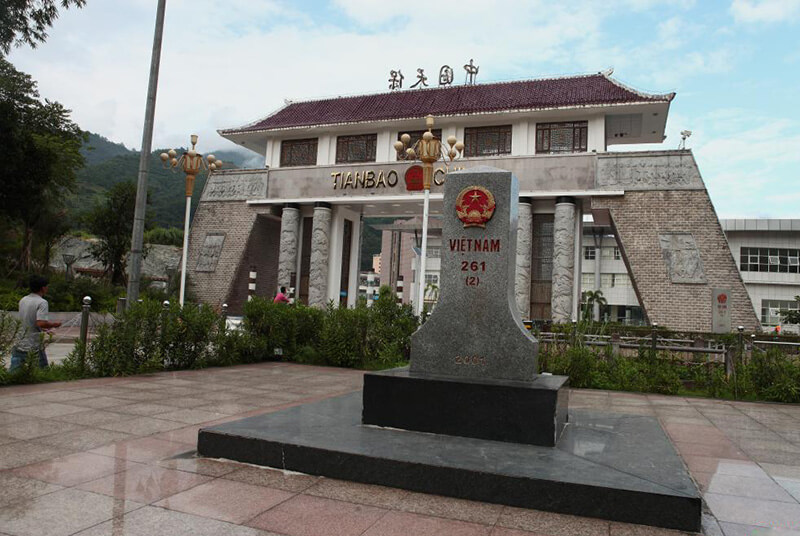
Thac Hung village – traditional silver carving craft of the Dao people
Nestled among the green tea hills and golden terraced fields of Vi Xuyen district, Ha Giang province, Thac Hung village of the Dao people is home to long-standing stilt houses that give visitors an interesting feeling because of the charming scenery. Most of the stilt houses were built by people helping each other. The stilt houses are very beautiful and sturdy, this is a precious tradition still preserved to this day.
This place still preserves a traditional craft that requires the skill and sophistication of the craftsman, which is silver carving. The silver carving profession is passed down from generation to generation, and children and grandchildren in the family must also learn this profession. The profession of silver engraving in many places is gradually disappearing, so preserving and maintaining it is very important.
Carving silver requires meticulousness and patience. Dao ethnic costumes cannot lack typical jewelry, which are hand-carved silver bracelets. In the wedding ceremony, funeral silver is also important. Products made from silver are both a unique tourist gift and a keepsake of the national identity of the Dao people in Cao Bo.
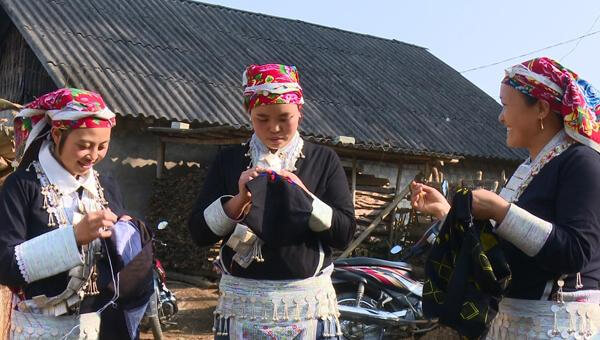
Thien Huong village – cultural community tourism village
Thien Huong community cultural tourism village is located about 5 km northeast of Dong Van town center. The village is home to 43 households of the Tay, Nung, and Giay ethnic groups; Of which the Tay ethnic group is the majority with over 200 people. According to the introduction of village head Luong Dinh Ninh, the Tay and Nung community have lived here for a long time. Nowadays, families still retain many traditional cultural features imbued with their nation’s identity, expressed in festivals, costumes, cuisine as well and daily living practices.
Coming to Thien Huong, visitors will be impressed by a green space between four rocky mountains, the highlight of which is a population of ancient banyan trees over 100 years old located right at the beginning of the village. In May 2015, 4 banyan trees in the population were recognized as heritage trees, ranging in age from 700 – 750 years old. Nestled among the banyan tree complex is the local people’s Temple of Lam God. In the third lunar month of every year, when the corn and rice plants have turned green in the fields, villagers in the village eagerly prepare to worship the Lam god. The offerings include many local products and traditional dishes such as black pork, local chicken, upland sticky rice, and cakes made by the skillful and capable hands of Tay and Nung women.
On the main day of the ceremony, girls, boys, old people, and young people all get up very early, prepare their most beautiful traditional costumes, and carry offerings in their hands to the temple area. The Than Lam worshiping ceremony is held very solemnly, imbued with the original features of a spiritual festival of the people here to pray for the village to have a year of good weather, lush crops, and prosperous homes. Everyone is healthy. After the shaman completes the ritual, villagers will enjoy food right at the temple. Visitors will enjoy the traditional dishes of the people here, drink a cup of fragrant Thien Huong leave-fermented corn wine, and immerse themselves in the smooth and profound melodies of Then, Coi, and love songs.
The report house is a unique and typical cultural feature of Thien Huong. The houses reported here are mostly old houses over 100 years old, built on flat ground, leaning against the mountain, the walls are made of rammed earth, the roof is covered with yin and yang tiles, and the trusses and doors are carved. made from wood. The house has 3 main rooms and 2 doors. Surrounding the house is a sturdy stone fence planted with many trees such as peaches, plums, and pears, creating the unique housing architecture of the people on the Stone Plateau.
Come to Thien Huong to immerse yourself in the peaceful and quiet life of the highlands. Stepping into the warm walled houses nestled at the foot of Po Lo mountain, next to a cozy fire with the homeowner enjoying simple rural products and drinking a cup of fragrant leaf-fermented corn wine, will definitely make you happy. lingering in the footsteps of tourists when they once came to Thien Huong…
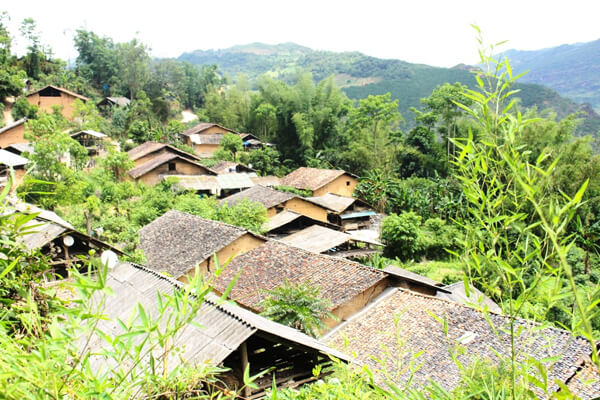
Lung Tam brocade weaving village – a treasure of the Mong people
Lung Tam brocade weaving village is located in Lung Tam commune, Quan Ba district, Ha Giang province. The brocade-weaving village has been around for a long time. Brocade weaving creates jobs for many people in the village, bringing high income. In the past, weaving tools were very rudimentary, mainly hand-woven products with traditional motifs. After many years of existence, the Quan Ba district government decided to develop the brocade weaving village.
Weaving has been invested in all aspects such as machinery, equipment, and textile materials. In addition to the products already produced, people will be guided to create modern products, to innovate, and attract customers. Now brocade weaving not only serves the family but also brings high income. New, quality motifs have brought high economic efficiency. Tourists love brocade products, especially foreigners.
Nowadays, many Mong people rarely or no longer maintain this brocade weaving tradition. Preserving and developing is very necessary, it is a tradition, a unique cultural feature.
When visiting Lung Tam brocade weaving village, you will see firsthand the skilled workers creating their products. The Mong ethnic people consider brocade weaving as a treasure. Making a brocade product is very elaborate. The main raw material is flax fibers that people grow themselves. After two months, they are dried, and then carefully separated each flax fiber to avoid breakage. The flax rolls are pounded in a mortar to remove all the flour leaving the tough fibers, then boiled in a lot of water mixed with kitchen ash and beeswax.
Until the flax fiber is opaque white, start weaving. After weaving, dry in the sun and wash with beeswax to make the fabric smooth and white. Clothes made from linen are very durable and thick. You can buy a few small products as meaningful gifts.
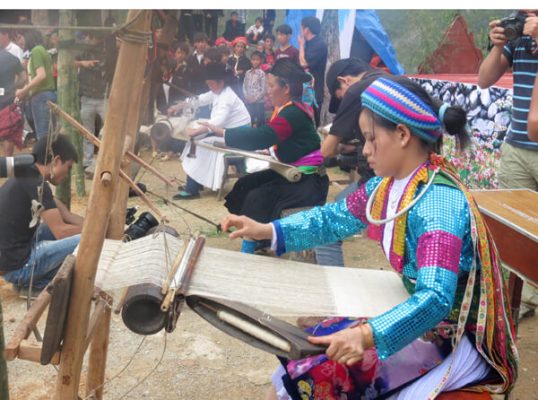
Noong Lake – the eyes of the forest
On the Ha Giang rocky plateau, everyone thinks this country is just a mountain pass with clouds and dry rocky slopes. But few people know that there is an “eye” of heaven and earth that was once known as the place of paradise in the rocky mountainous region of Ha Giang. That place is Ho Noong, a lake far away in the depths of the mountains, for thousands of years, brilliantly “gilded” by nature, a place that captivates every wandering wanderer. And this place will be even more “beautiful” because its fate is about to be like the “Shangrila: lost paradise” region on the Tibetan plateau, which is increasingly falling apart…
Noong Lake is more than 20 km from Ha Giang city center. This is a blue natural freshwater lake located at the foot of Noong Mountain. The lake is considered by local people to be the magic eye of the forest. What makes the difference is that in the heart of Noong Lake, there are both lush green trees and dry trees, creating an interesting natural picture.
April – October: In the rainy season, the lake water rises, and you can enjoy the lake with villagers on dugout boats or rafts. November – April next year: In the dry season, the water dries up to reveal old, leafless trees. The indigenous people have built up squares to release ducks and buffaloes on the green grass. Noong Lake has become an indispensable part of Ha Giang province. Noong Lake is a very good place to store water in the dry season. The characteristic natural green color makes Noong Lake unique. Nowadays, many rivers, streams, ponds, and lakes are polluted, but Noong Lake still retains its purity, which is a very precious thing.
Visiting Noong Lake, visitors also have the opportunity to explore the culinary talents of the Tay people. From fish caught from the lake to banyan ducks that are processed into grilled dishes, whether wrapped in soil or steamed with ginger, they all have an unforgettable sweet and sweet flavor… Come to Noong Lake to feel the greenness and nature. Beautiful nature and delicious food in the border highlands.
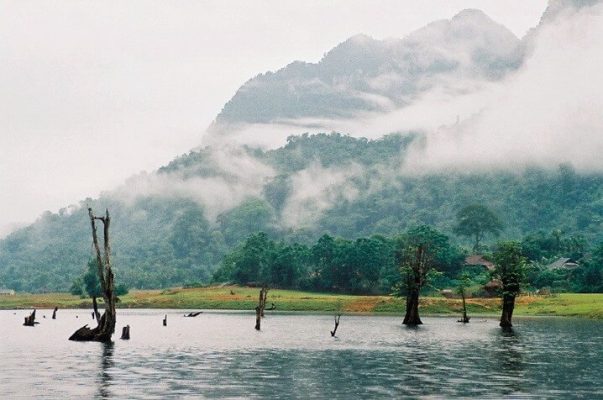
Sung La Valley – Pao’s home
Sung La is considered the most beautiful highland commune in the entire Dong Van stone plateau. Sung La Valley is located on National Highway 4C, connecting towns in Ha Giang, more than 20 km from Dong Van district. Anyone who comes to this land will feel that Sung La is gentle and peaceful.
The H’Mong people in Sung La grow buckwheat and mustard flowers on high hills and grow corn and rice on flat land at the bottom of the valley. Every day, people have to carry soil from far away and stuff it into each hollow of the rock, use rocks to block it to keep rainwater from washing away the soil, and then put seeds in. Green tree trunks grow up in the gray rocks as life still emerges in this barren land every day.
Since being chosen as the backdrop for the heartbreakingly beautiful footage in “Pao’s Story”, the “Four Great Fields” house of a famous H’Mong family many years ago has become a destination. is the most popular in Lung Cam village. Currently, in order to facilitate tourists’ visits, the house is being renovated and a sign with specific information is hung, including both Vietnamese and English. People remember a beautiful Miss Pao among the mustard flower fields. With this film, cinema has brought to the public the beautiful scenery of Vietnam’s mountains and rivers amidst the arid rocky plateau. “Pao’s house” is like a miniature picture of the life of the H’ people. The buttocks are full of mysterious and seductive beauty.
After the success of the movie, “Pao’s House” has become the most popular destination in Lung Cam. That is the two-story, mud-walled house of Mr. Mua Sua Pao. Lung Cam is also famous for its buckwheat flower fields, sown in the fields right at the entrance to Pao’s house. “Pao’s house” belongs to the ancient aristocracy of the H’Mong ethnic people in the northernmost region of Vietnam. It has a 2-story main room divided into many living rooms and living rooms, and an additional room divided into 2 small rooms, the house. warehouse, kitchen, and a barn for livestock and poultry. The house is built in four directions clustered in the middle with a yard creating a cozy and peaceful space. The colorful costumes of local girls are like decorative motifs on cat-ear stones that are as beautiful as a painting.
People here are honest, and simple, they are very open and hospitable. Coming here, visitors will truly feel comfortable and relax very peacefully. For many years now, every time Tet comes and spring comes, Sung La Valley – the main setting in the movie “Pao’s Story” has been bustling with more and more tourists coming to visit.
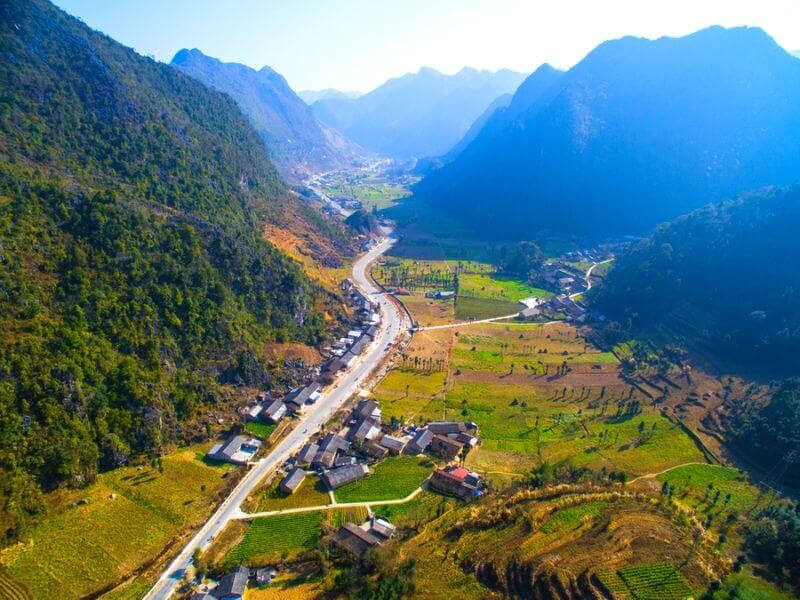
Son Vi – the village at the top of the Fatherland
50 km from Meo Vac town, Son Vi is the furthest commune of Meo Vac district and also the first village in the country. Son Vi borders China. With the emerald green Nho Que stream weaving between soaring rocky cliffs and winding roads between mountains, Son Vi is captivatingly beautiful thanks to that wild, majestic look. The road to Son Vi goes close to the Vietnam – China border, the road on the left is just a few steps away from China. Son Vi is also famous for the Ma Pi Leng Pass and Son Vi love market on the 28th of the third lunar month every year.
People say: “Son Vi is as beautiful as its name” which is not wrong. Along the winding cliffs is the clear and blue Nho Que River. The winding roads are like winding silk threads, making this place as beautiful as a watercolor painting.
Son Vi is a poor, wild, mysterious border commune, located in the farthest and highest position in the East of Meo Vac district, Ha Giang province. From Dong Van town to Meo Vac, about 24km, is a unique road running down the Nho Que river called the legendary Ma Pi Leng – the pass is likened to: “Not yet at Pi Leng” (translation: Not yet at Pi Leng is not a master backpacker).
Cross the bridge of the horse’s nose go to the foot of the pass and turn right to find the Son Vi basin. Both sides of the road are peaceful with branches of reeds and weeds about 50cm high. Breathe in your chest and enjoy the wonderful things on the journey to the distant border region that is gradually approaching your eyes, touching closer to the jade river, admiring the mountains and rivers of the mountainous region. Challenging countless curves to get close to the strange emerald green Cinnamon Grape stream. On this border road, you will cross a bridge called Trang Huong.
After wandering deep into Son Vi commune, if it’s past noon, stop by the market corner to recharge. In a deserted place, finding a restaurant at noon is not easy, so eating a pot of instant noodles is even more impressive and profound.
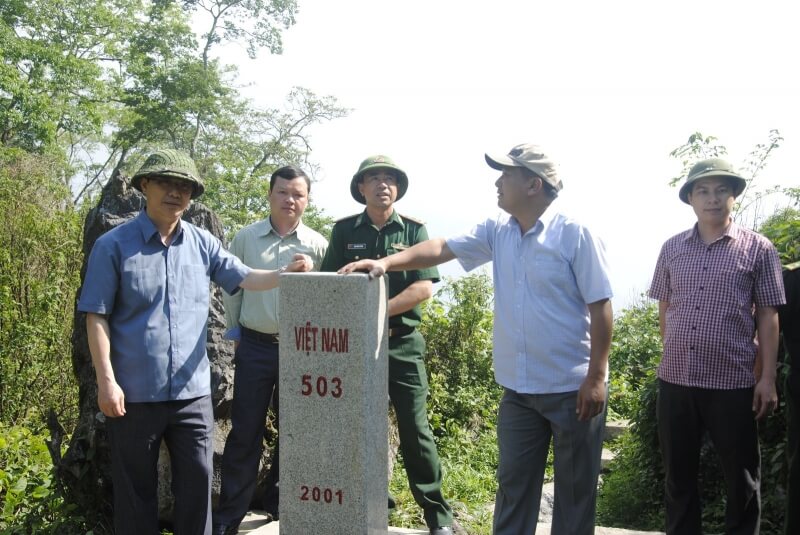
Vuong’s palace – opium palace
King Meo Vuong Chinh Duc’s mansion in Dong Van, Ha Giang is a project with the most unique architecture in Ha Giang province, ranked by the State as a national architectural and artistic relic. This is a destination not to be missed for tourists when coming to Ha Giang.
The Vuong palace has existed for more than 100 years and was built within 9 years by King Meo who hired the best workers. The Vuong Dynasty is a valuable historical relic of Dong Van district in particular and Ha Giang province in general. The construction cost at that time was 150,000 silver coins, equivalent to 150 billion VND.
The King’s Palace has a unique architecture, built entirely by human strength, the mansion’s foundation was built with very large rocks, before building the Cat King’s Palace, the terrain had to be chosen very carefully. The mansion is located in a high place, standing on the mansion you can see the surrounding panorama. Large, sturdy wooden panels are used to make columns and walls surrounding the house. The quality of the wood is very good, so after more than a century, there have been no termites or signs of damage. The mansion is very large, with many rooms, so the Vuong family’s descendants live happily and comfortably.
The Vuong Dynasty Palace is a historical witness to the fact that since ancient times, people were able to build large, solid structures. When visiting the Mansion, you will be introduced to the Mansion by a tour guide. That tour guide is also a descendant of the Vuong family. The Vuong Palace is where a lot of opium is stored to supply most districts and neighboring provinces of Dong Van, so people call this the Opium Palace. King Meo was the owner of the house and also the owner of the opium warehouse, so at that time he was very rich and powerful in the area. This is a very interesting historical site, please visit to understand about the biggest and richest house of that time.
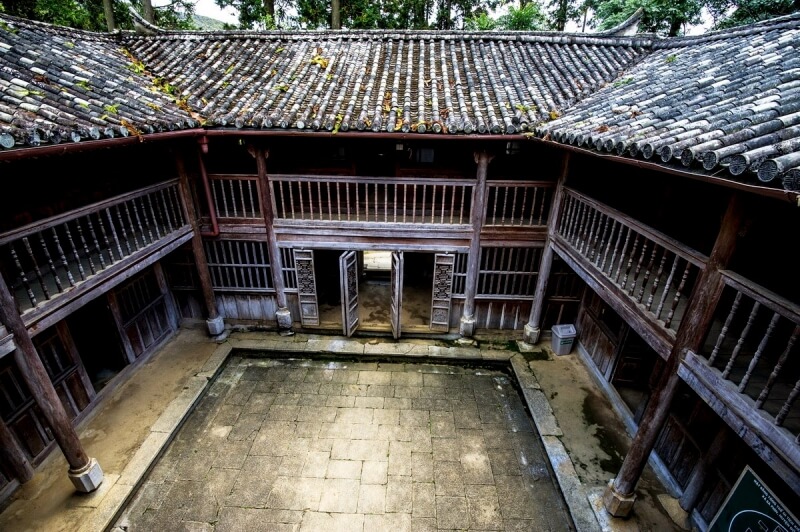
Lung Khuy Cave – the first cave in Ha Giang
Lung Khuy Cave in Lung Khuy village, Quan Ba commune, Quan Ba district is known as the most beautiful of the caves discovered in the Dong Van Karst Plateau Global Geopark. Lung Khuy Cave is located over 10km from the center of Quan Ba district. According to experts’ assessment: This is a valuable heritage in terms of geology, geomorphology, and tourism with a total length of over 300m, in addition to many other branch systems. The cave has pristine beauty with many splendid stalactites and strange shapes, creating a rare natural beauty.
To reach Lung Khuy cave, visitors must go through a dirt road more than one kilometer long around the mountain. Standing at the cave entrance from above, visitors will admire the entire natural scenery of Can Ty commune. Inside the cave, visitors can easily move around because the walkway system is built with sturdy iron frames. Above the dome of the cave are stalactites created over hundreds of years.
Colorful lights help visitors easily observe magical stalactites with many different shapes. Going deep inside the cave, many stalactites with strange shapes stimulate the imagination of visitors. The stalactites in Lung Khuy cave are all very pristine and have many shapes such as flowers, towers… Many stalactites with different shapes are arranged very uniquely, making visitors excited. With its pristine beauty, Lung Khuy cave is considered the second most beautiful cave in the Dong Van stone plateau.
After a period of closure, the cave has now reopened and attracts thousands of visitors. Bringing great economic resources to Quan Ba district in particular and Ha Giang province in general.
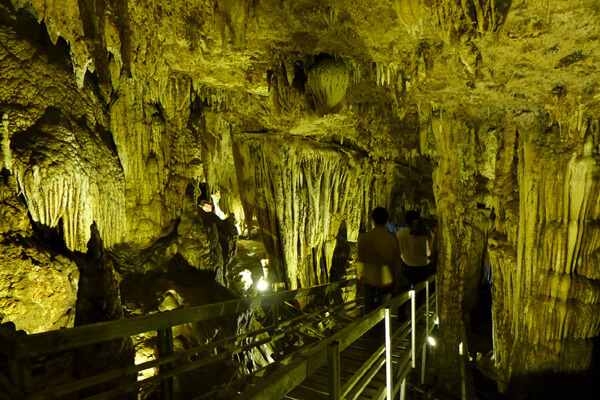
Phin Ho tea village – ancient Shan Tuyet tea
Ha Giang in recent years has become a destination attracting many tourists. Ha Giang tourist destination conquers visitors with its rocky mountains touching the clouds, golden terraced fields of ripe rice, or vast green tea hills. And Phin Ho village is one of the prominent destinations most people mention when coming to this land.
Currently, there are quite a few cheap Ha Giang tours where you can see where tour organizers go to Ha Giang. Therefore, the opportunities to come to this land with so many things to explore are also more than before. Once you get here, don’t forget to spend time at Ban Phin Ho.
Phin Ho village is located in Hoang Su Phi district of Ha Giang province, which has a natural area of up to 77 hectares and is home to 44 households of more than 200 Dao ethnic people. Phin Ho village is located in the most remote and highland area, so most people still have difficulties, but Phin Ho village is always a friendly destination that many people remember. This place is famous for its hundreds of years old tea trees that were planted a long time ago. People in Phin Ho village who want to pick tea will have to climb trees to pick it because the ancient tea trees are very big and tall, unlike the small tea trees in other regions such as Thai Nguyen. Ancient tea is very delicious because of its long-lasting nature, the tea is produced entirely using natural methods and ingredients, moreover, ancient tea trees grow at the highest place of Phin Ho village where the weather is cool all year round. In September and October, the tea buds are filled with the vitality of heaven and earth. The dew drops are absorbed by the tea leaves, creating the purity and delicious aroma typical of Phin Ho tea.
Since then, the Phin Ho tea brand has become known to many people, especially those who like to enjoy tea. When they go to the highlands of Ha Giang, they will definitely buy it to enjoy and give as gifts. Up to now, ancient tea trees are still living and growing, cared for, and harvested by the people here. This is not only a famous brand but also the cultural beauty and preservation of the national identity of the people of Phin Ho village.
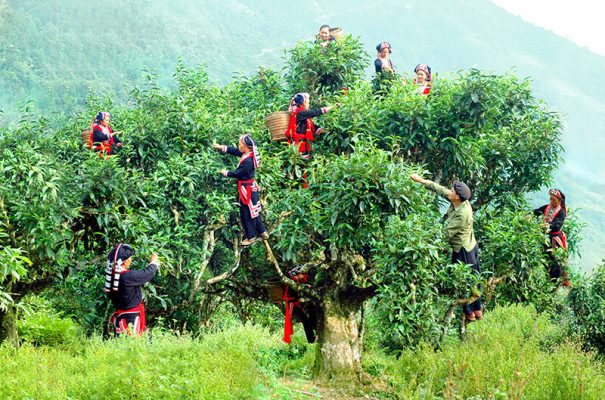
Related Article: Top 7 Experiences for backpacking in Ha Giang and things to prepare
Ha Giang is a land with many things that you have not yet discovered. Come to find peace and lightness amidst the chaos of life. Hopefully, with the sharing of the Vietnam Reviewert, you will understand more about the land of Ha Giang, the beginning of the Fatherland. Vietnam Reviewer hopes that all of you will have a nice trip to Halong Bay. If you have any feedback or need help, please send an email to vietnamreviewer.contact@gmail.com!
Noted: All information and pictures are collected

